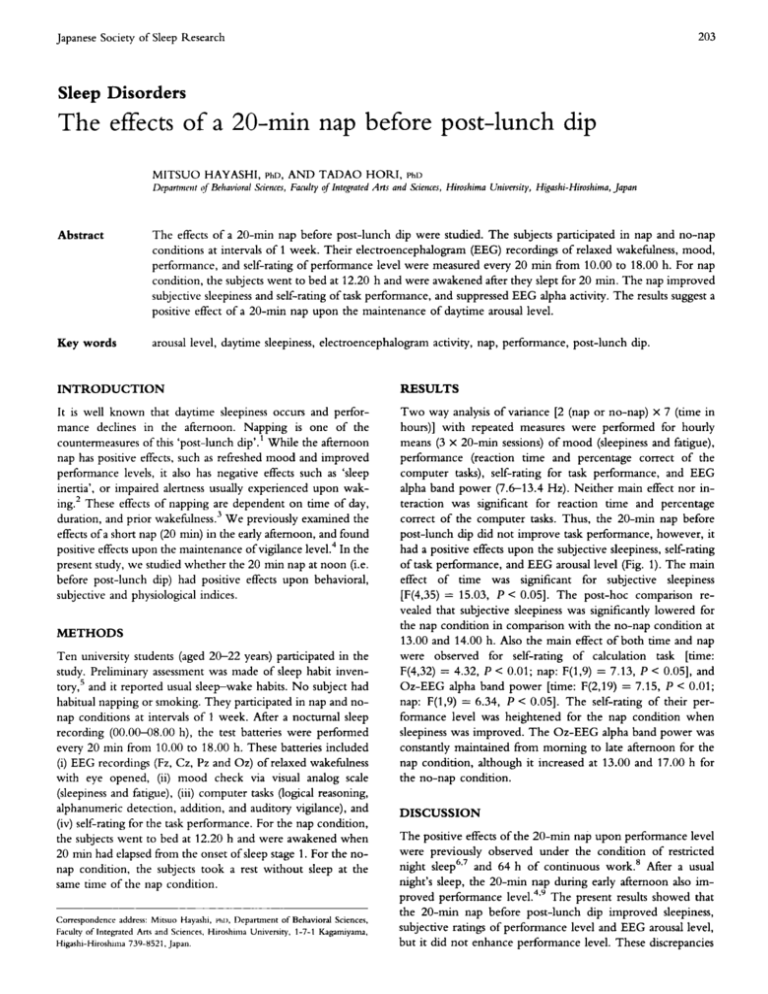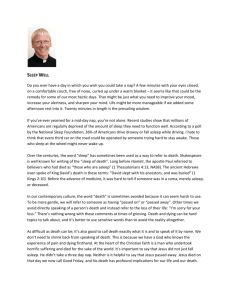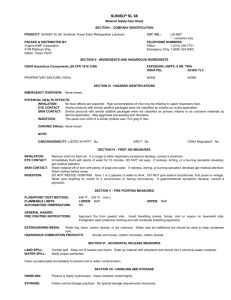The effects of a 20‐min nap before post‐lunch dip
advertisement

203 Japanese Society of Sleep Research Sleep Disorders The effects of a 20-rnin nap before post-lunch dip MITSUO HAYASHI, PhD, AND TADAO HORI, DepartniFnt of Behaviural Sciences, Faculty of Integrated Arts and PhD Sciences, Hiroshima Ufliversiry, Higashi-Hiroshima, Japan Abstract The effects of a 20-min nap before post-lunch dip were studied. The subjects participated in nap and no-nap conditions at intervals of 1 week. Their electroencephalogram (EEG) recordings of relaxed wakefulness, mood, performance, and self-rating of performance level were measured every 20 min from 10.00 to 18.00 h. For nap condition, the subjects went to bed at 12.20 h and were awakened after they slept for 20 min. The nap improved subjective sleepiness and self-rating of task performance, and suppressed EEG alpha activity. The results suggest a positive effect of a 20-min nap upon the maintenance of daytime arousal level. Key words arousal level, daytime sleepiness, electroencephalogram activity, nap, performance, post-lunch dip. INTRODUCTION RESULTS It is well known that daytime sleepiness occurs and performance declines in the afternoon. Napping is one of the countermeasures of this ‘post-lunch dip’.’ While the afternoon nap has positive effects, such as refreshed mood and improved performance levels, it also has negative effects such as ‘sleep inertia’, or impaired alertness usually experienced upon waking.’ These effects of napping are dependent on time of day, duration, and prior wakef~lness.~ W e previously examined the effects of a short nap (20 min) in the early afternoon, and found positive effects upon the maintenance ofvigdance level.4 In the present study, we studied whether the 20 min nap at noon (i.e. before post-lunch dip) had positive effects upon behavioral, subjective and physiological indices. Two way analysis of variance [2 (nap or no-nap) x 7 (time in hours)] with repeated measures were performed for hourly means (3 x 20-min sessions) of mood (sleepiness and fatigue), performance (reaction time and percentage correct of the computer tasks), self-rating for task performance, and EEG alpha band power (7.6-13.4 Hz). Neither main effect nor interaction was significant for reaction time and percentage correct of the computer tasks. Thus, the 20-min nap before post-lunch dip did not improve task performance, however, it had a positive effects upon the subjective sleepiness, self-rating of task performance, and EEG arousal level (Fig. 1). The main effect of time was significant for subjective sleepiness [F(4,35) = 15.03, P < 0.051. The post-hoc comparison revealed that subjective sleepiness was significantly lowered for the nap condition in comparison with the no-nap condition at 13.00 and 14.00 h. Also the main effect of both time and nap were observed for self-rating of calculation task [time: F(4.32) = 4.32, P < 0.01; nap: F(1,9) = 7.13, P < 0.051, and Oz-EEG alpha band power [time: F(2,19) = 7.15, P < 0.01; nap: F(1,9) = 6.34, P < 0.051. The self-rating of their performance level was heightened for the nap condition when sleepiness was improved. The Oz-EEG alpha band power was constantly maintained from moming to late afternoon for the nap condition, although it increased at 13.00 and 17.00 h for the no-nap condition. METHODS Ten university students (aged 20-22 years) participated in the study. Preliminary assessment was made of sleep habit invent o r ~and , ~ it reported usual sleep-wake habits. No subject had habitual napping or smoking. They participated in nap and nonap conditions at intervals of 1 week. After a nocturnal sleep recording (00.00-08.00 h), the test batteries were performed every 20 min from 10.00 to 18.00 h. These batteries included (i) EEG recordings (Fz, Cz, Pz and Oz) of relaxed wakefulness with eye opened, (ii) mood check via visual analog scale (sleepiness and fatigue), (iii) computer tasks (logical reasoning, alphanumeric detection, addition, and auditory vigdance), and (iv) self-rating for the task performance. For the nap condition, the subjects went to bed at 12.20 h and were awakened when 20 min had elapsed from the onset of sleep stage 1. For the nonap condition, the subjects took a rest without sleep at the same time of the nap condition. Correspondencr address: Mitsuo Hayashi. phi). Department of Behavioral Sciences, Faculty of Integrated Arts and Sciences. Hiroshima University. 1-7-1 Kagamiyama, Higarhi-Hiroshma 739-8521, Japan. DISCUSSION The positive effects of the 20-min nap upon performance level were previously observed under the condition of restricted night sleep6.’ and 64 h of continuous work.8 After a usual night’s sleep, the 20-min nap during early afternoon also improved performance level.4.’ The present results showed that the 20-min nap before post-lunch dip improved sleepiness, subjective ratings of performance level and EEG arousal level, but it did not enhance performance level. These discrepancies 204 Psychiatry and Clinical Neurosciences S I eep i ness -30 3: 30 1 r S e l f - r a t ing(Ca1cuIat ion) m subjects slept before post-lunch dip. Chronobiological aspects of arousal level should be further considered to examine the effects of short nap. ACKNOWLEDGMENT This study was supported in part by the Special Coordination Funds for Promoting Science and Technology of the Science and Technology Agency of the Japanese Government. 0 REFERENCES -30 5 r EEG a I pha (Oz) m * -5 L 10 11 12 13 14 15 16 17 Time of day Figure 1. Hourly means of sleepiness, self-rating of calculation task, and Oz-EEG alpha band power ( n = 10). The data were normahzed via mean scores a t 10.00 and 11.00 h set to 0 level. **P < 0.01, *P < 0.05, + P < 0.1. of the results between the previous studies and present study might be explained by the arousal level when napped. In the previous study, the subjects took a nap when their sleepiness level was relatively high due to reduced night sleep or postlunch dip, but it was not high in the present study because the 1. Dinges DF, Broughton RJ. Sleep and Alertness: Chronobiological, Behavioral, and Medical Aspects ,$Napping. Raven Press, New York, 1989. 2. Stampi C. W h y We Nap. Birkhauser, Boston, 1992. 3. Naitoh P. Circadian cycles and restorative power of naps. In:Johnson, LC, Tepas, DI, Colquhoun WP, Colligan MJ (eds), Biological Rhythms, Sleep and Sh$ Work. Spectrum, New York, 1981; 553-580. 4. Hayash M, Hori T. The effects of a 20-minute nap in the early afternoon. Psychiat. Clin. Neurosti. 1997; 51: S58. 5. Miyasita A. Sleep habit inventory (Me habit inventory). In: The Japanese Society of Sleep Research (ed.), Handbook ,$ Sleep Science and Sleep Medicine. Asakura-syoten, Tokyo, 1994; 533-538 (in Japanese). 6. Stampi C , Muhngton J. Rivers M et a / . Umashort sleep schedules: Sleep architecture and the recuperative value of multiple 80-, 50-, and 20-min naps. In: Home JA (ed.), Sleep ‘90. Pontenagel, Bochum, 1990; 71-74. 7. Gillberg M, Kecklund G, Axelsson J ef al. The effects of a short daytime nap after resmcted night sleep. Sleep 1996; 19: 570-575. 8. Naitoh P, Kelly TL, Babkoff H. Napping, stimulant, and four-choice performance. In: Broughton RJ. Ogdvie RD (eds), Sleep, Arousal, and Petjormance. Birkhauser, Boston, 1992: 198-219. 9. Maeda M, Aritomi R, Shirakawa S. Effects of daytime short timenap-sleep on rekeshment on brain function. Sleep Env. 1993; 1: 6 3 4 8 (in Japanese). Sleep Disorders Prolonged polysomnography in a case with recurrent hyp ersornnia EIICHI TANABE, MD, KAZUO Y A M , MD, MASATO MASTUURA, MD, S A M TAKAI-IASHI, MD, TEIICHIRO SAKAI, MD, AND TAKWA KOJIMA, MD Department ,$ Neuropsychiatry, Nihorr University School ,$Medicine, Tokyo, Japan Abstract An 18-year-old male patient with recurrent hypersomnia (RH) was evaluated using prolonged polysomnography (PSG). During symptomatic period (SMP), the patient showed both ‘dissociated stage REM’ (DREM), REM sleep without muscle atonia and ‘dissociated stage 1’ (DSt-l), and stage 1 sleep with rapid eye movement. These stages were observed in the morning or following daytime record. They decreased during asymptomatic period (ASMP). It has been said that RH is caused by dysfunction ofthe hypothalamus and midbrain limbic system. The present result suggests also that RH involves dyshnction of the brain stem. Key words dissociated stage REM, dissociated stage 1 prolonged polysomnography, recurrent hypersomnia.







